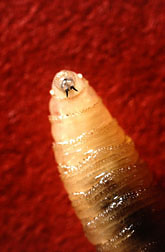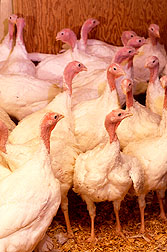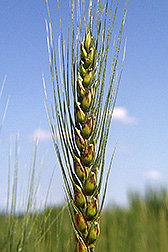Tuesday, May 30th, 2006
Low Vitamin D of Young African-Americans
|
|
Young African-Americans’ Low Vitamin D Levels Reported
By Marcia WoodMay 25, 2006
Low vitamin D levels among young African-Americans participating in a recent study were more common than in several previous investigations, university and Agricultural Research Service (ARS) nutrition experts have found.
The vitamin is essential for strong bones and a robust immune system, according to the study’s lead author, immunologist Charles B. Stephensen. He works at the ARS Western Human Nutrition Research Center, located at the University of California, Davis.
Stephensen and his co-investigators have reported their findings in the current issue of the American Journal of Clinical Nutrition.
The scientists based their conclusion on levels of a form of vitamin D in the blood (plasma) of 359 volunteers, aged 15 to 19, tested at sites in 14 American cities. Volunteers were predominantly female African-Americans.
Researchers found that 87 percent of the volunteers had an insufficient amount of what’s known as 25-hydroxyvitamin D in their plasma. Though some earlier studies had suggested that more Americans than was previously estimated may be short of vitamin D, the 87 percent figure was unexpectedly high, according to Stephensen.
People who have levels of 25-hydroxyvitamin D at or below 37.5 nanomoles per liter of blood are considered vitamin D-deficient.
Good sources of the nutrient include vitamin D-fortified milk, fatty fish and sunshine, which a natural chemical in skin can convert to a form of the nutrient called previtamin D3.
The study was funded in part by ARS—the U.S. Department of Agriculture‘s chief scientific research agency—and by the National Institutes of Health, part of the U.S. Department of Health and Human Services.
The study volunteers represented a majority of the participants in the federally funded REACH investigation, short for “Reaching for Excellence in Adolescent Health.”
Stephensen worked on the study with colleagues from the University of Southern California at Los Angeles; Iowa State University at Ames; the University of Pennsylvania at Philadelphia, and the University of Alabama at Birmingham.
Fighting “Brush Fires” With Science
| Read the magazine story to find out more. |
|
|
Quelling Trade “Brush Fires” With Science
By Jim De QuattroMay 17, 2006
What do Algeria, Aruba, Brazil, Canada, China, Cuba, Romania and Vietnam have in common?
All of them have been at the center of a scientific question with trade or other burning international implications for themselves or the United States. And all the questions were resolved through work of the Agricultural Research Service.
While the questions varied, time was always of the essence in settling the situations, according to an article in the May issue of the agency’s Agricultural Research magazine.
In 2000, for example, Brazil banned U.S. wheat imports because of fears of the wheat seed gall nematode. That was serious business, because Brazil is the largest buyer of U.S. wheat in South America. But the ban was lifted in early 2001 after ARS researchers proved to the Brazilians’ satisfaction that the nematodes were not a threat.
According to ARS nematologist David Chitwood, the Brazilians came to ARS because the agency has the most expertise in identifying nematodes and, as a nonregulatory science agency, has nothing at stake in a trade issue.
Among a half-dozen other episodes of quick-acting international research in recent years, the magazine cites:
- In March 2004, Aruba had an outbreak of screwworm, a painful parasite that can infest almost any warm-blooded animal–from livestock to tourists. But by October, ARS’ sterile-insect-release technology had eliminated screwworms from the small Caribbean island–just as it had worked earlier with international cooperators to eliminate the pest from the United States, Mexico and almost every country in Central America.
- In 2002, China notified the World Trade Organization about new tests for gauging the quality of cotton fiber imports. But ARS analyses of the tests persuaded Chinese officials not only to postpone use of the new tests, but also to move toward modernizing that nation’s cotton classification system.
ARS is the chief scientific research agency of the U.S. Department of Agriculture.
Quicker Test for Turkey Viruses
|
|
A Quicker, Cheaper Test for Turkey Viruses
By Sharon DurhamMay 23, 2006
A new, highly sensitive diagnostic test to detect viruses associated with poult enteritis complex, or PEC, has been developed by Agricultural Research Service (ARS) scientists in Athens, Ga. This disease of young turkeys causes diarrhea, poor weight gain and, in some cases, high mortality.
Microbiologists Erica Spackman and Darrell Kapczynski developed the test in a format that allows the detection of several types of viruses at one time. Spackman works in the ARS Endemic Poultry Viral Diseases Research Unit, and Kapczynski is in the Exotic and Emerging Avian Viral Disease Research Unit. Both units are part of the ARS Southeast Poultry Research Laboratory. The scientists collaborated on the research with Holly Sellers of the University of Georgia.
The test relies on a molecular technique called real-time reverse transcription- polymerase chain reaction (RRT-PCR), which is a highly sensitive and specific method for detecting viral RNA. Current diagnostic methods for PEC-associated viruses have limitations because of poor analytic specificity and sensitivity.
The researchers inoculated turkey poults with each of the PEC-associated viruses and later collected intestinal tissue samples and cloacal swabs from the experimentally infected birds. The RRT-PCR test showed high sensitivity, accurately detecting the target viruses in both the tissues and swabs.
While intestinal samples have previously been essential to making a definitive PEC diagnosis, the researchers found that cloacal samples—which are easier to collect and process—were just as suitable for testing. Using them will not only save time and money, it will also eliminate the need to euthanize birds for sampling.
The PEC-test technology has been provided to several laboratories for diagnostic use, and the research team is now working on adapting the RRT-PCR technique to diagnose related diseases in chickens.
ARS is the U.S. Department of Agriculture’s principal scientific research agency.
Cleanup Help for a Chesapeake Watershed
New Grant to Help Clean Up Chesapeake Watershed
By Sharon DurhamMay 19, 2006
Agricultural Research Service (ARS) scientists are part of a consortium that has received an $800,000 research grant to implement farming management practices that could improve water quality in the Choptank River watershed, which drains into the Chesapeake Bay. ARS is the chief scientific research agency of the U.S. Department of Agriculture (USDA).
The consortium received the funding from the National Fish and Wildlife Foundation via its Chesapeake Bay Targeted Watersheds Grant Program.
The consortium includes ARS, the Maryland Department of Agriculture, Caroline Soil Conservation District, USDA’s Natural Resources Conservation Service, the University of Maryland-Extension Service, the University of Maryland’s Horn Point Laboratory, the Smithsonian Environmental Research Center, public drainage associations and local farmers.
Chemist Laura L. McConnell, who works in the ARS Environmental Management and Byproduct Utilization Laboratory at Beltsville, Md., and soil scientist Gregory W. McCarty in the ARS Hydrology and Remote Sensing Laboratory, also at Beltsville, are leading the ARS component of the project.
Both labs are part of the ARS Henry A. Wallace Beltsville (Md.) Agricultural Research Center, which is part of the Chesapeake Bay watershed that includes about 64,000 square miles in six states. The Chesapeake is the nation’s largest fresh water estuary.
Agriculture is the primary land use in the Choptank River watershed, accounting for 58 percent of the land. ARS scientists, along with the rest of the consortium, aim to enroll 6,000 acres per year in a commodity cover crop as a pilot program to study the feasibility of large- scale implementation of this strategy in the Choptank watershed.
By implementing this program, the consortium estimates a short-term reduction of 30,000 pounds per year of potential nitrogen loading into the Choptank River. Installation of drainage controls will reduce potential nitrogen loading by an additional 1,600 pounds per year, and will also help establish new wetlands and enhance wildlife habitat.
Protein Protects Against Mastitis
Novel Antimicrobials Protect Against Mastitis-Causing Bacteria
By Rosalie Marion BlissMay 24, 2006
An Agricultural Research Service (ARS)-led team has combined specific DNA segments from two different sources to produce a novel antimicrobial protein. The resulting “fusion” antimicrobial protein degrades the cell walls of several bacterial pathogens in a solution of whey extracted from cow’s milk.
Agriculturally, the technology provides a key step to developing dairy cows that have a natural, built-in defense against mastitis—a disease that costs U.S. dairy producers up to $2 billion annually.
In the realm of infectious disease, one way to reduce microbial resistance that results from widespread antibiotic use is to come up with new ways to fight pathogens. The findings from this experimental study were published in the April 2006 issue of Applied Environmental Microbiology.
David M. Donovan, a molecular biologist at the ARS Biotechnology and Germplasm Laboratory at Beltsville, Md., presented the study’s results today at the American Society for Microbiology‘s 2006 annual meeting, in Orlando, Fla. ARS is the U.S. Department of Agriculture‘s chief scientific research agency.
Donovan is the named inventor on a USDA/ARS-filed patent application that describes the technology behind fusing the protein-coding DNA sequences that produce the novel fusion antimicrobial. He and colleagues from Birmingham, Ala., and Quebec, Canada, hope to use the technology to produce fusion proteins as alternatives to the use of broad-range antibiotics both in clinics and on farms.
While all milk contains several naturally occurring antimicrobial proteins, such as lysozyme and lactoferrin, the sale of milk containing the fusion protein would first require rigorous food safety testing and federal regulatory approval.
Bacteria have layers of macromolecules that provide strength and shape to their cell walls. The fusion antimicrobial protein, as a cell-wall-degrading enzyme, kills pathogens by decomposing this structural layer and causing the cell to break down.
The B30-lysostaphin fusion protein developed by Donovan’s team is active against both Staphylococcus aureus and three streptococcal mastitis pathogens that together are responsible for up to 50 percent of the dairy cattle mastitis that occurs in the United States.
Surprisingly Exotic Boxwood
|
|
Arboretum Scientist Brings Back Boxwood From Far-Flung Places
By Alfredo FloresMay 18, 2006
Lynn R. Batdorf has searched far and wide for boxwood in efforts to diversify the collection he curates at the U.S. National Arboretum in Washington, D.C.
Batdorf, a horticulturalist, has been curator of the arboretum’s National Boxwood Collection since 1977, carefully tending about 150 different species and cultivars in one of the world’s most complete boxwood collections. The arboretum is operated by the Agricultural Research Service (ARS), the chief scientific research agency of the U.S. Department of Agriculture.
Batdorf, who recently discussed his boxwood collection efforts at the 46th American Boxwood Society Meeting and Symposium in Memphis, Tenn., in 2002 began exploring for boxwood in Azerbaijan, a former Soviet republic that is home to many rare species. Foreigners have only recently been allowed to visit that country for plant exploration. During an expedition to the Chirkan Nature Reserve, in the towns of Lankaran and Astara, Batdorf discovered Buxus colchica, a very large (30 feet tall) and ancient (over 250 years old) boxwood.
In January 2006, Batdorf registered a new Korean semidrawf boxwood (Buxus sinica var. insularis), dubbed Wee Willie, in the Boxwood Bulletin, a quarterly journal of the American Boxwood Society (ABS). This boxwood has straight, vertical stems with dense, dark-green leaves and excellent cold hardiness.
Other valuable boxwood in the arboretum’s collection includes Vardar Valley (Buxus sempervirens) from Macedonia, a variety known for its fragrant flowers, shallow roots, and resistance to leaf miners and mites. Another notable variety is Curly Locks (Buxus microphylia), a medium-sized plant with small, curly leaves.
In addition to writing and illustrating the comprehensive Boxwood: An Illustrated Encyclopedia, Batdorf recently compiled and released his latest findings in Boxwood Handbook: A Practical Guide (3d. edition). Both are available through the nonprofit ABS.
Silencing Wheat and Barley Scab
|
|
Silencing Wheat and Barley Scab
By Don ComisMay 26, 2006
A new test to find scab-resistance genes in wheat and barley seed heads uses the plants’ natural viral defense mechanism to temporarily “silence” the gene to be tested. The test is an adaptation of a technique called Virus-Induced Gene Silencing (VIGS).
Agricultural Research Service (ARS) geneticist Steven Scofield and colleagues developed the test with funds from the U.S. Wheat and Barley Scab Initiative managed by ARS. Scofield is in the ARS Crop Production and Pest Control Research Unit at West Lafayette, Ind.
Under the initiative, farmers and scientists work together to combat scab—also known as Fusarium head blight—one of the most devastating wheat and barley diseases worldwide. Currently, there are only a few wheat and barley varieties with effective levels of resistance to scab.
The test temporarily incapacitates wheat or barley genes thought to be important to scab resistance, to see if the plant’s scab resistance also disappears temporarily.
Scofield began experimenting with VIGS when he first came to ARS in 2002. With it, he found four genes key to leaf rust resistance in wheat and barley plants. He is working to adapt VIGS to find resistance genes for each major wheat and barley disease, one at a time.
Before this VIGS-based test, there was no way to assess probable genes for scab resistance other than through breeding, or by inserting them into tissue cells and then regenerating whole plants for testing. The new test is much quicker and more efficient since it can be done shortly after a plant is infected with a virus, without waiting to grow a new plant.
VIGS has been used for about 10 years. Scientists first used it with tobacco, then tomatoes, potatoes and Arabidopsis thaliana.
ARS is the U.S. Department of Agriculture’s chief scientific research agency.
Entomology Pioneer’s Notes Online
| Among recently rediscovered notes of Asa Fitch were some of the very earliest observations on invasive aphid pests to the United States, such as the cabbage aphid, “brought here…on shipboard.” Also shown below is a lithograph of the cabbage aphid that was found with Fitch’s notes. (Images courtesy ARS Systematic Entomology Laboratory, which hosts an Asa Fitch website.) |
Entomology Pioneer’s Notes, Still Relevant, Now Online
By Luis PonsMay 22, 2006
The actual handwritten observations about aphids made by Asa Fitch, a 19th-century pioneer of U.S. insect studies, can now be viewed at an Agricultural Research Service (ARS) website. The documents had spent more than a century tucked away in a collection in Maryland.
The site, called “Resurrecting Asa Fitch’s Aphid Notes: Historical Entomology for Application Today,” offers nearly 800 pages of notes by Fitch—some written on recycled galley proofs and handbills—that discuss approximately 190 aphid species.
According to entomologist Gary Miller of the ARS Systematic Entomology Laboratory (SEL), the notes are of great scientific and historic value, yielding glimpses of Fitch’s personality and shedding light on the language and lifestyle of the times.
The well-preserved writings feature data on aphids’ life history, morphology, predators and host plants, much of which is still relevant today. They include references to the cabbage aphid, Brevicoryne brassicae, which in 1791 possibly became the first invasive aphid identified in North America. Fitch was also first to record several other invasive aphids, including, in 1846, Liosomaphis berberidis, whose description is found on the site.
The website was compiled at SEL by Miller, entomologists Ethan Kane and Robert Carlson, and technician Jonathan Eibl.
Fitch, who was born in 1809, became the first professional entomologist appointed by a state when New York hired him in 1854. He published more than 200 reports and articles on insects and related topics.
When Fitch died in 1879, his entomological collection and library were sold to collectors and the U.S. National Museum, and—according to Miller—his aphid notes and some specimens went to where they are today: the U.S. Department of Agriculture’s National Aphidoidea Collection in Beltsville, Md., which is now managed by SEL.
SEL has laboratories and offices in Beltsville and at the Smithsonian Institution’s Museum of Natural History in Washington, D.C.
You can view Fitch’s notes through SEL’s homepage.
ARS is the USDA‘s chief scientific research agency.









